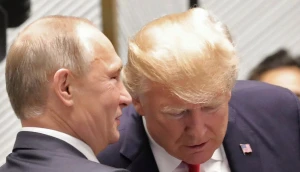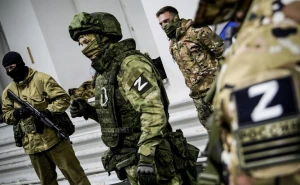
August 14-21 live war map: Russia approaches Pokrovsk agglomeration, occupies New York, loses Kursk region
Russia once again intensified its attack on Pokrovsk, increasing the number of attacks to a record 347 over the week. This allowed Russian troops to break through several more of Ukraine's strongholds and occupy a number of villages. Meanwhile, the offensives on Toretsk and Vuhledar were also prioritized, with Russian forces aiming to encircle these cities. However, the situation has reversed in several areas of the Kursk region, where Russian troops found themselves surrounded
Threat of Vuhledar encirclement becomes more real
As anticipated, Russian forces succeeded in severing the road between Vuhledar and Kostiantynivka village, and have advanced to the southern outskirts of Vodiane village. They have also established positions in several areas north of Vodiane, potentially threatening the road and creating additional risks for Ukraine's defenses from another direction. Although Vuhledar still has a supply route, it is only 7 kilometers away in a straight line, presenting a significant threat to Ukrainian Defense Forces in this sector. However, Russian resources are nearing exhaustion, and their offensive momentum is waning, particularly in light of the internal situation in Russia.
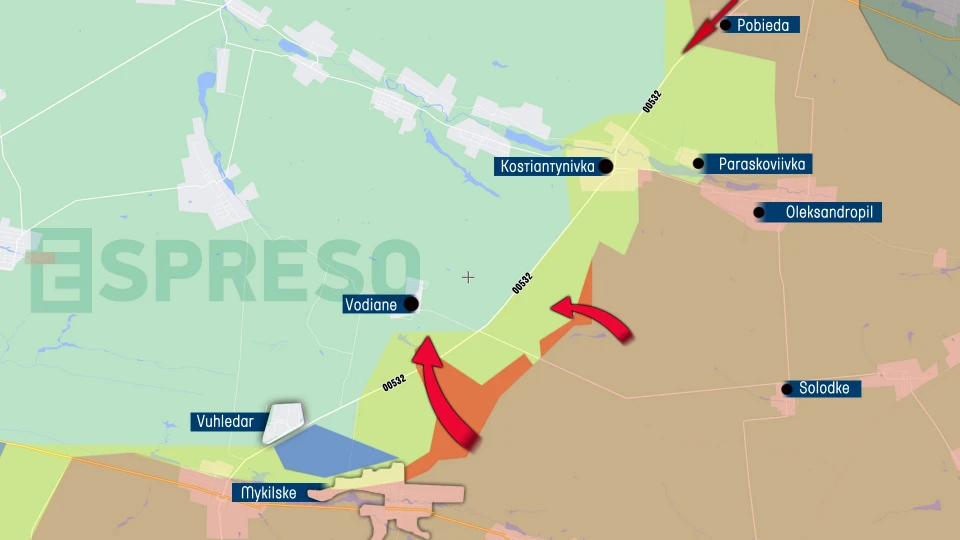
Battle for the Pokrovsk agglomeration has begun
In the Pokrovsk direction, Russian troops outnumber Ukraine's at least three to one, and the ratio of losses is one to ten in Ukraine's favor, which gives an understanding of the overall situation and hope that Russia's offensive will soon exhaust its resources.
So far, Russian forces have managed to breach all Ukrainian defensive lines set up to prevent their advance towards Pokrovsk. They successfully exploited gaps between the rivers, bypassing the Vovcha and Zhuravka Rivers, which allowed them to approach the outskirts of the Pokrovsk agglomeration and initiate their assault on Hrodivka. They also progressed along the railroad tracks, encountering the urban development of Novohrodivka. However, capturing the Pokrovsk agglomeration—comprising five towns and several villages across three districts, with a pre-war population of 385,000—would to be a complex forRussian troops. The battle for Pokrovsk could extend over several months or even longer. Currently, Russian troops have been halted approximately 10 kilometers from the city.

The offensive on Hrodivka has been going on for two weeks now, but without any progress. So Russian forces began to bypass the town from the south, moving along the Zhuravka River, captured the village of the same name and approached the outskirts of Krasnyi Yar. However, a system of water barriers awaits them here, so the offensive will slow down. Russia will again look for gaps in the Ukrainian defense, probably near Novohrodivka or further south. For now, their offensive is mostly aimed at the south, whereRussian troops are still making progress. Here, they occupied Zhelanne and Mykolaivka, entered Novozhelanne and Zavitne, and completely pushed the Ukrainian Defense Forces from the left bank of the Vovcha River, north of the Karlivka reservoir. In Karlivka itself, the Ukrainian Armed Forces have been holding the line for several months, not retreating a single step. However, they could be threatened by an attack from the northern flank, from where Russian troops are advancing toward Kalynove. If Russia does manage to break through Ukraine's defenses near Komyshivka and Kalynove, the Ukrainian Armed Forces will have to withdraw from Karlivka and take up new positions along the line in front of Ukrainske and Selydove.
Occupation of New York and the Battle of Toretsk
In the past month and a half, Russian forces have nearly completed the occupation of the Ukrainian settlement of New York. Ukrainian Defense Forces continue to hold positions in the northern part of the settlement, but Russian troops are outflanking them from all directions, allowing them to advance towards Toretsk from both the east and the south. It is anticipated that Russia will soon attempt to build on this success by capturing Toretsk from the west as well. Currently, intense fighting is occurring on the southern and eastern outskirts of Nelipivka, which serves as a southern defense for Toretsk. The Ukrainian Armed Forces are working to repel the advancing occupying forces and are also making efforts to outflank New York from the west to maintain their northern positions.
In addition, the Russian army will try to break down Ukraine's defenses near the villages of Panteleimonivka and Oleksandropil and move along the road to Kostiantynivka. However, they are currently making attempts to enter the southern outskirts of Panteleimonivka and drive a wedge between the Ukrainian defensive redoubts in these villages.
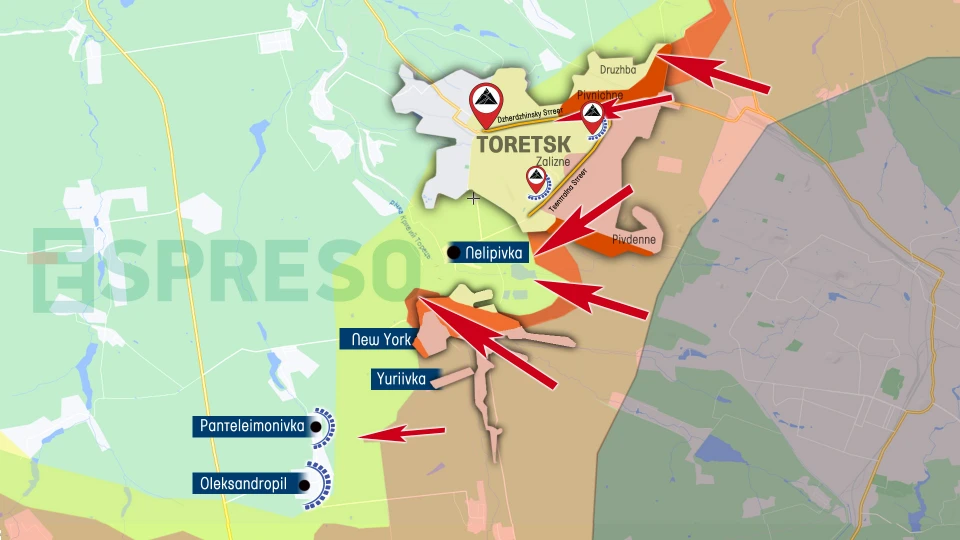
In Toretsk itself, the defense line continues to run through Tsentralna Street and the three spoil tips that rise above it. Russian troops attack all three spoil tips simultaneously, but their frontal assaults are unsuccessful, so they try to bypass the heaps from the north, breaking through the main Dzerzhynskoho Street. At the same time, they are expanding their control to the villages of Pivnichne and Druzhba, thus trying to surround Toretsk from the north as well. At this time, Pivnichne is 90% occupied and Druzhba is 50% occupied.
The battle for Toretsk may become one of the most decisive in this war, as its results will affect many other areas of the front.
Chasiv Yar, Siversk, Kupyansk and Vovchansk
In most parts of the frontline, the number of battles has decreased, and Russian forces are not making any progress. In Chasiv Yar, the Ukrainian Defense Forces continue to hold back the Russian army and prevent it from gaining a foothold on the right bank of the canal, destroying all those who make such attempts. The number of such attempts has decreased. The situation at the Siverskyi and Lyman directions is steadily tense, but the invading Russian troops are not making any progress. The offensive on Kupyansk also continues, and they have not significantly expanded their zone of control near Pishchane, as they need to protect their flanks before launching a serious offensive on the city. However, the pace of their advance indicates that this will not happen quickly, if they decide to assault Kupyansk at all this year. In Vovchansk, the Russian front is stagnating, as some troops had to be sent to help in Kursk. Hence, there is likely to be good news from the Ukrainian Armed Forces soon.
Buffer zone of Kursk region
As of August 20, Ukraine recognized that it controls 93 settlements and 1,263 square kilometers of territory in the Kursk region. The Kursk operation has already justified itself by 200%, but as it continues, new horizons and prospects are emerging: more captured, more eliminated, and more territory between the Seim and the Psel. Instead, Russians are fleeing: at least 120,000 have already fled on their own, and another 60,000 have been evacuated by the authorities, which is about 18% of the population of the Kursk region. The FSB is completely evacuating the population of Lgov and Rylsk districts, as well as partially three other districts of the region.
In the eastern part of the front, the Ukrainian Armed Forces tried to expand it and enter the Belgorod region near the villages of Demidovka and Kolotilovka, but the Russians have a lot of military and well-developed logistics here, so both attempts failed. However, the further west Ukraine's units go, the better the situation is for them. Southeast of Sudzha, the Ukrainian Defense Forces continue to advance along both banks of the Psel River. Russians report Ukrainian presence not only in Vorozhba, but also in Girya and Belitsa.
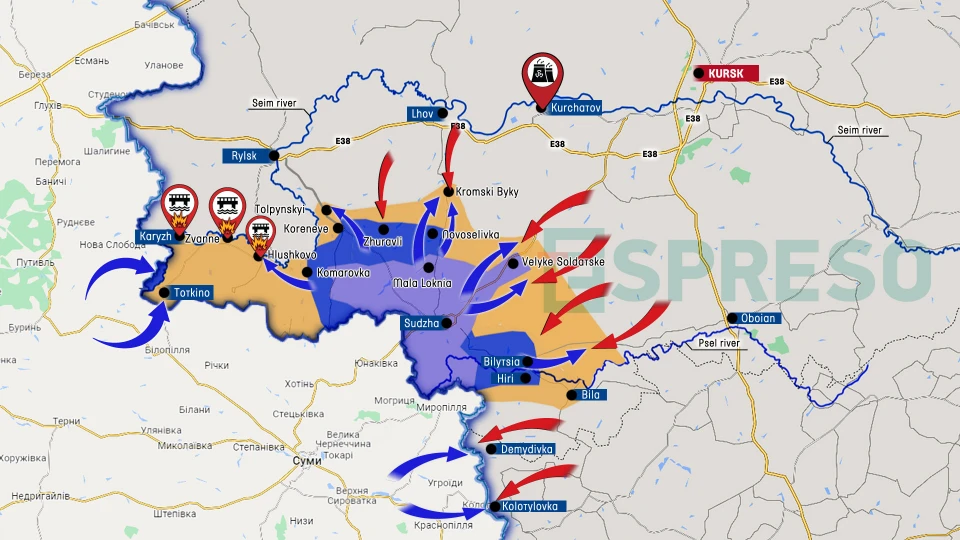
Russia made the most attempts to counterattack on the Kursk-Sudzha highway, in particular between the villages of Bolshoye Soldatskoye and Martinovka, but they failed. Instead, the Ukrainian Armed Forces are developing an offensive on the E38 Rylsk-Kursk highway. It is this highway that is key for the deployment of Russian reinforcements to the north of the front in the Kursk region. However, the Ukrainian army artillery is firing along the entire route, and Ukraine's drones are actively working on it. Therefore, there is a high probability that the Ukrainian military will soon take the road somewhere between Rylsk and Lgov and cut off the logistics. It is difficult to predict exactly where this will happen, as the Ukrainian Armed Forces are moving north along the road to Luhansk, and parallel to it through villages and forest roads. For instance, Russian artillery has been observed targeting the villages of Zhuravli and Novoselovka, indicating the presence of Ukrainian troops in those areas. In response, Ukrainian artillery has struck Lgov, where the railway station was recently hit. Additionally, in the Malaya Loknya area, Ukrainian paratroopers from the 95th Brigade have encircled units of the 18th Motorized Rifle Division of the Russian Armed Forces.
Further west, Ukrainian troops not only entered Korenevo and pushed Russian forces out of the central part of the village, but also bypassed it from the south and north, taking fire control of the road to Rylsk. From the north, the Ukrainian Armed Forces advanced through the villages of Olgovka and Vetreno and entered Tolpinsky, located directly on the road to Rylsk. From the south, they occupied the villages of Snagost, Apanasovka and began the battle for Komarovka. Earlier, the Ukrainian Armed Forces captured 102 Russian soldiers, including those from the Akhmat special forces, near the checkpoint in the village of Gordeyevka and continued to move along the border.
Presumably, in the near future, Russian troops who are surrounded in Korenevo will either surrender or be killed, as they will not be able to swim across the wide Seim in these places.
Eventually, the Ukrainian Defense Forces created a large trap for several thousand Russian soldiers on an area of 250,000 square kilometers, who were surrounded between the Ukrainian border and the Seim River. To do this, the Ukrainian Armed Forces destroyed three bridges over the Seim in the villages of Karizh, Zvannoye, and Glushkovo. Russian attempts to build pontoon bridges also result in the destruction of equipment that they try to transport across them. Russian troops at Tetkino and other checkpoints on the border are in a stalemate: they cannot retreat, and they will soon have nothing to fight with. Therefore, in the near future, we expect the entire Glushkovsky district to come under the control of the Ukrainian Defense Forces, as happened in the Russian Federation between the Ukrainian border and the Seim River, northeast of Tetkino.
Despite all these losses of territory and troops, Russia is in no hurry to transfer troops from Donetsk region to Kursk. They are currently planning to gather 5-6 battalions from other areas, mostly from Kharkiv, Luhansk, Zaporizhzhia, and Kherson regions, and are also deploying troops from Kaliningrad. Putin has allegedly set a goal of pushing the Ukrainian Armed Forces out of Russia by October, but it is unlikely that they will succeed with such support.
Russia is on fire
For the past four days, one of the largest oil depots in Rostov Proletarsk, which previously supplied the frontline with jet fuel and diesel, has been ablaze. The facility, which houses 70 oil tanks valued at $180 million, first ignited when 11 tanks caught fire from a drone strike. The blaze then spread to an additional 11 tanks, and last night, more Ukrainian drones continued the assault, causing further explosions. Despite the efforts of nearly 500 rescuers and 130 pieces of equipment, the fire is spreading rapidly, with some rescuers already injured. That’s why Moscow priests were dispatched to conduct a prayer service to save the remaining oil. Meanwhile, Ukrainian drones reportedly targeted Moscow, and the outcomes of these strikes are yet to be confirmed.
The maps were created on the basis of information received from the Ukrainian Armed Forces General Staff, as well as from other open and verified sources. At the same time, the maps are not as accurate as possible and only conditionally reflect trends in the combat zone.
- News








